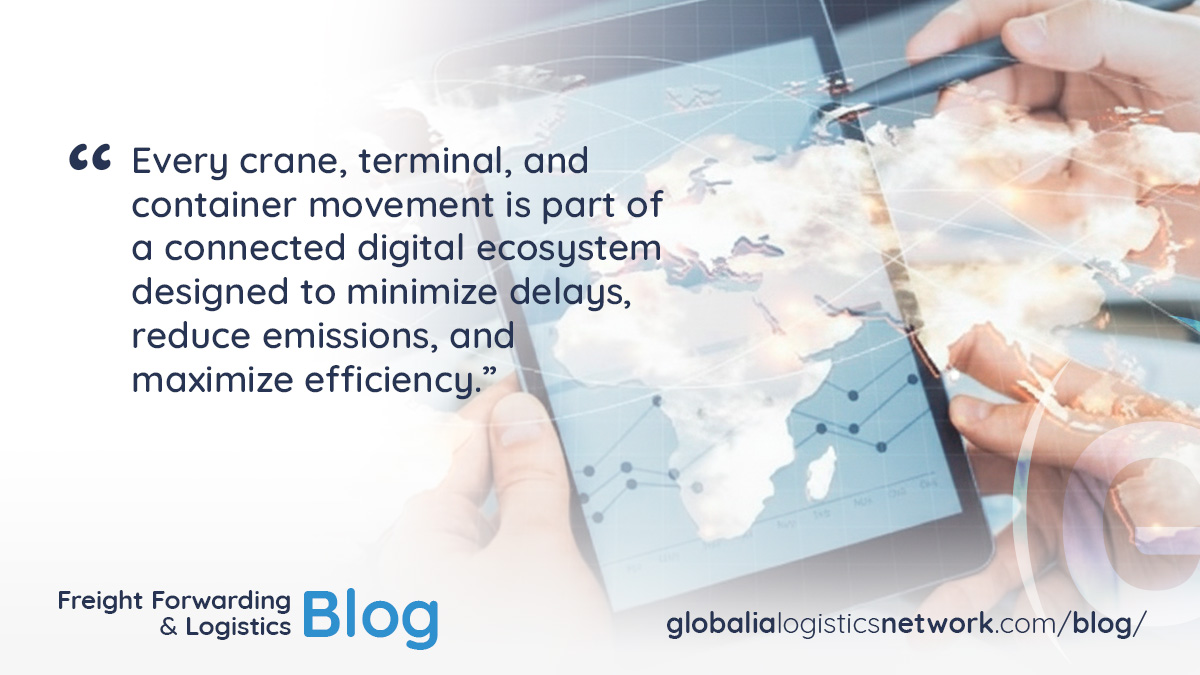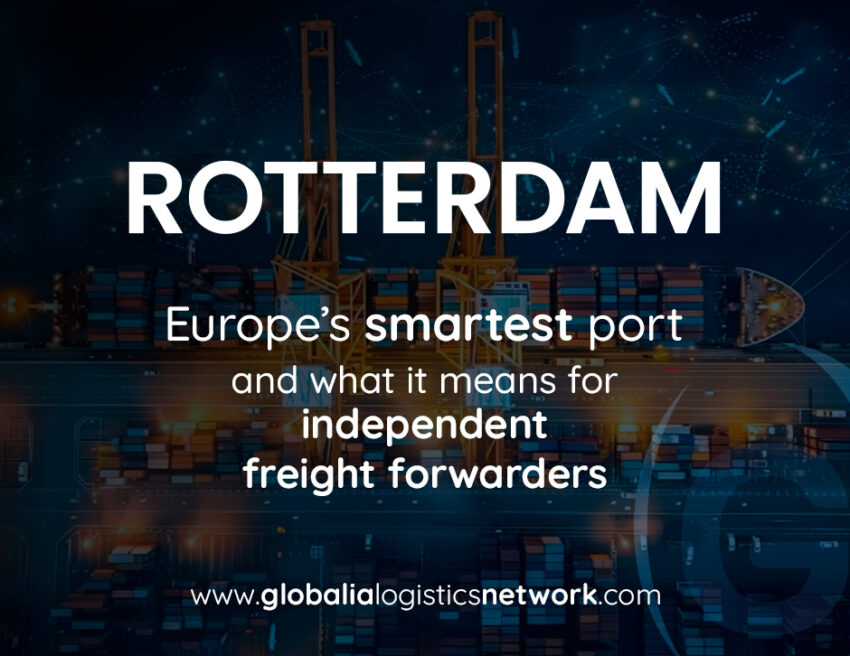If you want to see what the future of global trade looks like, head to the Netherlands. More precisely, to the Port of Rotterdam, Europe’s busiest, smartest, and arguably most innovative maritime hub. The way Rotterdam port automation has reshaped logistics gives us a preview of what’s coming for the rest of the world. But this isn’t just a story about technology. It’s about opportunity, especially for freight forwarders who understand how to adapt, partner, and innovate within a rapidly changing landscape. In today’s article, we will take a look at the factors that make Rotterdam Smart Port so advanced, how its digital ecosystem works, and what independent forwarders can learn from it.
The Port of Rotterdam: A Living Laboratory of Innovation
The port of Rotterdam stretches over 40 kilometers along the North Sea coast, serving as the main gateway between Europe and the rest of the world. Handling more than 470 million tonnes of cargo annually, it’s Europe’s largest and most digitally advanced port.The port has become a testing ground for automated port logistics, artificial intelligence, real-time data exchange, and even autonomous vessels. Every crane, terminal, and container movement is part of a connected digital ecosystem designed to minimize delays, reduce emissions, and maximize efficiency. This transformation is driven by a clear mission: to become the world’s smartest and most sustainable port. And that’s exactly where SmartPort Rotterdam comes in.

What Is a Smart Port and Why It Matters for Logistics
A “smart port” is essentially a data-driven ecosystem. Instead of relying purely on manual coordination between shipping lines, customs, and terminal operators, smart ports use digital twins, IoT (Internet of Things) sensors, AI algorithms, and blockchain to synchronize every aspect of cargo movement. In Rotterdam Smart Port, this means that ships communicate their arrival times automatically, cranes operate semi-autonomously, and predictive analytics determine the most efficient route for each container. The result is a system that saves time, cuts costs, and enhances reliability—benefits that ripple across the entire logistics chain. For logistics companies, it translates into fewer uncertainties, faster turnaround times, and better visibility over shipments.
Rotterdam Port Automation: Redefining Global Logistics
At the heart of this evolution is Rotterdam port automation, particularly in the Maasvlakte 2 terminal, one of the most advanced in the world. Here, self-driving vehicles move containers between ships and storage yards without a single human driver. Cranes load and unload vessels autonomously, guided by laser sensors and AI-driven control systems.
Every operation is tracked and optimized in real time. For logistics companies, this means unprecedented predictability and precision. How Rotterdam port automation benefits forwarders comes down to efficiency and data. Automated systems minimize waiting times and reduce the risk of human error. This reliability allows freight forwarders to plan with confidence, promising clients tighter delivery windows and more accurate ETAs. But automation isn’t just about replacing labor, it’s about reimagining how ports function in an age where data is as valuable as cargo.
Rotterdam Port Digital Tools: The New Standard
One of the key features of the Rotterdam Smart Port initiative is its investment in digital platforms. These Rotterdam port digital tools allow real-time sharing of information between vessels, terminals, agents, and freight forwarders. Imagine being able to see precisely when a ship will dock, when customs clearance will be completed, and when your cargo will be ready for pickup, all from a single dashboard. The data-driven infrastructure also feeds into the digital shipping corridor project between Rotterdam and major ports like Singapore, Hamburg, and Antwerp. This initiative aims to create a paperless, fully transparent global trade route where cargo data moves seamlessly alongside physical shipments. For independent freight forwarders, these tools level the playing field, allowing them to compete with larger companies by leveraging the same data-driven intelligence.
Rotterdam Port Expansion
Even with its massive scale, the Rotterdam port expansion is ongoing. The Maasvlakte 2 project, completed in phases, added over 2,000 hectares of reclaimed land to the port area. This expansion was designed for the future of maritime trade: automated terminals, sustainable energy hubs, and next-generation logistics facilities. Rotterdam is also investing heavily in green corridors and shore power infrastructure, aligning with Europe’s climate goals. Hydrogen terminals and carbon capture systems are already part of the blueprint. This commitment to innovation and sustainability ensures that Rotterdam remains at the forefront of global logistics for decades to come.
Challenges for Freight Forwarders in Automated Ports
As automation increases, human roles evolve. Traditional port agents and on-site coordinators may find their responsibilities shifting toward digital management and analytics. For smaller freight forwarders, this means that investing in technology and training becomes unavoidable. There’s also the issue of data access. Larger logistics corporations often have the financial resources to integrate directly with port systems, while smaller forwarders might depend on third-party tools or manual updates.
However, Rotterdam’s approach has been inclusive – encouraging collaboration between startups, SMEs, and port operators through innovation hubs and digital incubators. Independent forwarders who embrace these platforms can still thrive by focusing on flexibility, customer relationships, and niche expertise—areas where automation cannot compete.
How to Compete with Giants Using Rotterdam’s Tech
So, how to compete with giants using Rotterdam’s tech? The answer lies in smart adaptation. Forwarders don’t need to own massive fleets or develop proprietary software to benefit from automated port logistics. They just need to know how to use the tools already available in Rotterdam’s ecosystem.
-
Leverage Real-Time Data: Real-time visibility platforms give small and mid-sized forwarders the same visibility that multinationals enjoy. Use it to anticipate disruptions, optimize routes, and deliver more accurate updates to clients.
-
Embrace Digital Documentation: Rotterdam’s paperless customs systems reduce clearance times. Forwarders who digitize their documentation processes will stay ahead of competitors who still rely on manual paperwork.
-
Specialize in Value-Added Services: Automation handles containers, but not customers. Offering services like last-mile coordination, multimodal solutions, or cargo insurance consulting can set smaller forwarders apart.
-
Partner Strategically: Rotterdam encourages partnerships between technology providers, logistics startups, and forwarders. Tapping into these collaborations can open new opportunities for innovation without heavy capital investment.
By blending technology with personal service, independent freight forwarders can find their edge even in the world’s most automated environments.
The Digital Shipping Corridor: A New Trade Artery
The digital shipping corridor initiative between Rotterdam and Singapore is one of the most ambitious maritime digitization projects to date. It creates a standardized digital framework that allows ports, customs, and carriers to exchange verified data securely and instantly. For freight forwarders, this means simplified paperwork, faster approvals, and fewer administrative errors. The corridor effectively turns international shipping into a single connected process rather than a chain of disconnected steps. As more ports join this network, Rotterdam’s role as a data hub will be just as important as its role as a cargo hub. Forwarders that adapt early to this model will benefit from smoother global operations and better client satisfaction.
Lessons from Rotterdam for Freight Forwarders
The Rotterdam port experience offers clear lessons for forwarders worldwide:
-
Automation is not the enemy. It’s a tool that reduces uncertainty and increases operational control.
-
Data is the new currency. Access to accurate, real-time information is what differentiates top-performing forwarders from the rest.
-
Sustainability is now part of efficiency. Rotterdam’s push for renewable energy and green shipping isn’t just environmental—it’s economic. Lower emissions mean lower costs and higher compliance.
-
Collaboration beats isolation. Whether it’s through shared platforms or cross-industry partnerships, logistics is becoming a networked business.
Independent freight forwarders who align with these principles will not only survive but lead in the next generation of logistics.
The Bigger Picture: Rotterdam as a Model for the World
Rotterdam has emerged as a model for how ports everywhere could operate in the future. By blending automation, data intelligence, and sustainable design, the Dutch have created a system that’s both efficient and resilient. For freight forwarders, the takeaway is clear: the future of logistics will belong to the smartest and the ones ready to adapt. In many ways, the Rotterdam Smart Port has already redefined what’s possible. The rest of the logistics world is simply catching up.


